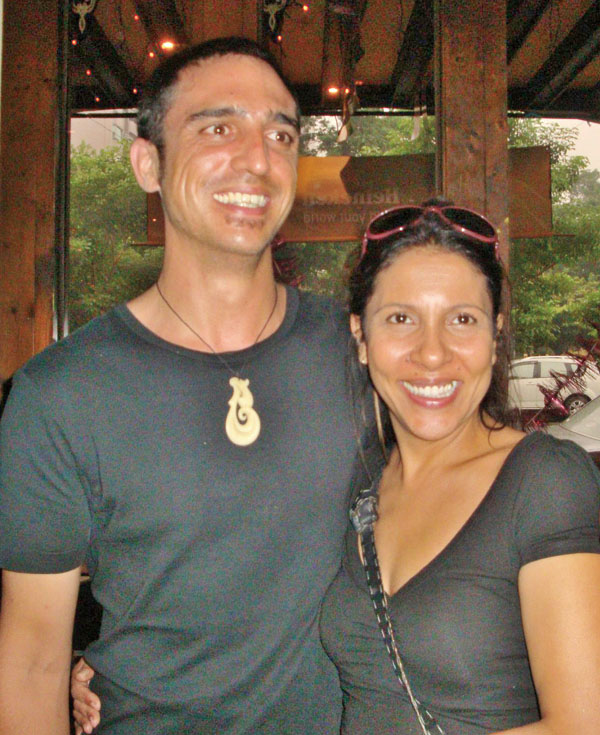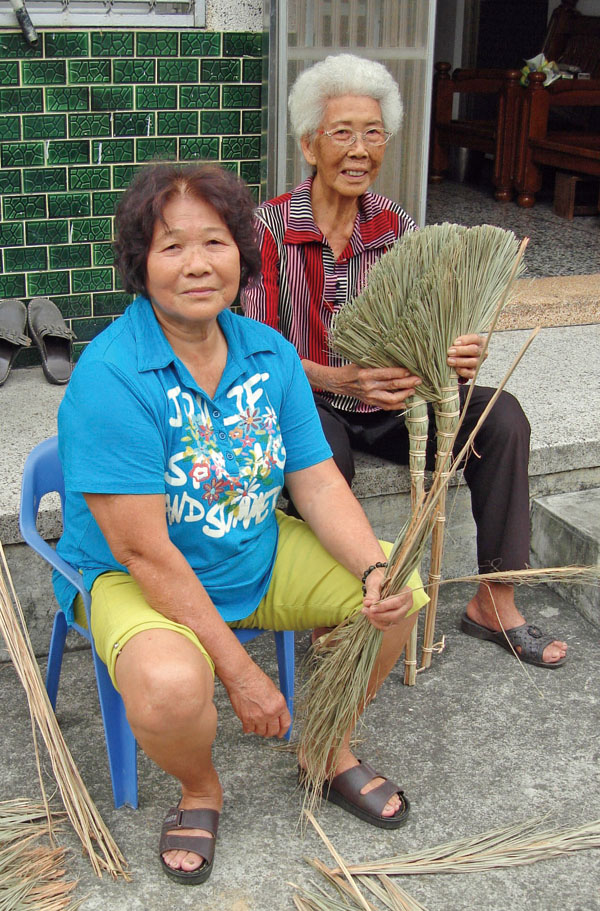Home Away From Home/他鄉是故鄉
Home Away From Home
◎English translation: Peng Hsin-yi
◎Photo courtesy of Maxine September
 Campbell Burns first met Maxine September, who later became his wife, in Kaohsiung back in 2002. Campbell is originally from New Zealand and Maxine is from South Africa. They have moved away from Kaohsiung a couple of times but always made their way back. They have now been living in Kaohsiung for the past six years and Campbell has just received his permanent resident certificate, allowing the whole family to stay in Taiwan indefinitely. They also have a son, Oliver, who was born in Kaohsiung. They consider Kaohsiung to be their home.
Campbell Burns first met Maxine September, who later became his wife, in Kaohsiung back in 2002. Campbell is originally from New Zealand and Maxine is from South Africa. They have moved away from Kaohsiung a couple of times but always made their way back. They have now been living in Kaohsiung for the past six years and Campbell has just received his permanent resident certificate, allowing the whole family to stay in Taiwan indefinitely. They also have a son, Oliver, who was born in Kaohsiung. They consider Kaohsiung to be their home.
Campbell and his partner Tom Lloyd have started a new business called Basscase. Basscase takes vintage cases and boxes and fits them with high-quality amps and speakers for mobile boomboxes. All the cases are handmade in Taiwan. Business is booming and soon they will be expanding into retail outlets in both Kaohsiung and Taipei.
The family currently resides near Chengcing Lake. They really enjoy the community-oriented environment and have many friends from all over the world. Maxine says: "Being away from our families can be hard, especially when you have a child of your own, so in many ways we rely on our friends like we would a family."
According to Campbell, Kaohsiung has made great strides in recent years. "It's amazing how many improvements have been made since we first came here 11 years ago. The air quality is much better. Lots of new parks have sprung up, the Kaohsiung MRT makes it easy to get about and it just seems like a much more livable city in general. The people are super friendly and the weather is amazing."
Maxine said her favorite part about living in Kaohsiung is the sense of security she enjoys. She never feels afraid, even when she walks alone on the streets. Maxine and Campbell agree that people in Kaohsiung are very warm and caring, and they like to help. They say that when they have asked for directions, people have actually dropped whatever they were doing and taken them where they wanted to go.
Campbell, Maxine and Oliver will always have a connection to Taiwan.
他鄉是故鄉
◎文/侯雅婷
◎照片提供/Maxine September
來自紐西蘭的Campbell Burns2002年首次遇見他未來的太太─來自南非的Maxine September,之後他們幾度各奔前程,但他們總會回到高雄,今年是他們在高雄定居的第6年,Campbell剛取得永久居留證,這讓Burns一家人可以永遠留在台灣,他們的孩子Olive在高雄出生,對Burns一家人而言,高雄是他們的家。
高雄也是Campbell發展事業的基地,Campbell和伙伴Tom Lioyd開發出Basscase這個以復古行李箱為外殼的音響,事業順遂且產品在市場上廣受矚目,未來計劃在高雄和台北開設門市。
Burns一家人定居於澄清湖附近,他們很喜歡澄清湖社區的生活環境,這裏住著許多不同國籍的好朋友,Maxine表示,對於夫妻倆都在工作的小家庭而言,當小朋友出生以後,由於家人不在身邊,所以他們極仰賴朋友互相照顧,因此他們與好朋友的感情就如同家人一般。
Campbell強調,近年來高雄有著非常顯著的進步,現在的高雄空氣品質好許多、興建許多新公園,再加上高雄捷運提供市民更便利的生活,使高雄成為一個宜居城市。Campbell稱讚高雄市是超級友善的城市,特別是南部高雄終年的好天氣,實在太棒了。
Maxine談起她最喜歡居住在高雄的原因是高雄帶給她的那份安全感,即使一個人走在路上她完全不必擔心,夫妻倆都認同,高雄人非常古道熱腸,當他們向高雄人問路時,高雄人是真的會放下手邊的工作,帶他們到目的地去。
Burns一家人將永遠和高雄緊扣在一起。
A Sweeping Cultural Heritage – Linyuan's Phoenix Palm Brooms
◎English translation: Peng Hsin-yi
◎Photo by Lin Yunsi
 To the most of us, a broom is simply a tool for cleaning. However, it means much more for people in Kaohsiung's Linyuan District; it is part of their cultural heritage. In Kaohsiung, the majority of phoenix-palm brooms are produced in Linyuan's Linnei Community and these days they are regarded as folk crafts. Back in the 1970s and 1980s when brooms were the primary cleaning tools in homes, Linnei produced half of all the brooms sold in Taiwan. The other major production site was Wandan in Pingtung County.
To the most of us, a broom is simply a tool for cleaning. However, it means much more for people in Kaohsiung's Linyuan District; it is part of their cultural heritage. In Kaohsiung, the majority of phoenix-palm brooms are produced in Linyuan's Linnei Community and these days they are regarded as folk crafts. Back in the 1970s and 1980s when brooms were the primary cleaning tools in homes, Linnei produced half of all the brooms sold in Taiwan. The other major production site was Wandan in Pingtung County.
Such brooms are made with phoenix palm leaves, shell ginger stems, and thorny bamboos. From a contemporary point of view, among their advantages are that they are completely biodegradable and environmentally friendly. In practiced hands, a pile of leaves and stems can become a broom in just 10 minutes. The most senior broom-maker in Linnei is Ms. Liu Su, who is now 83 years old. Ms. Liu says that she started making brooms when she was 14 and the process has not changed a bit. She would go up to the mountains and collect palm leaves, split each blade in three while they are fresh, and dry them under the sun for three to five days. Meanwhile, she'd make the twine that ties the brooms from tempered shell ginger stems. When they were ready, she would put them together with a thorny bamboo stick as the broom's backbone.
The cultural element of this unassuming household item comes from its ceremonial uses. Brooms are frequently employed to "sweep away bad atmosphere" during folk religious events such as the inauguration of a new home or religious pilgrimages through a neighborhood. When used in such events, brooms are purchased in pairs and tied with additional red twine to symbolize festivity and good fortune. When in pairs, they are called "the brooms of heaven and earth." The "heaven broom" is used to sweep high-up places while the "earth broom" is used for the grounds. The area is properly cleansed of impurities, seen and unseen. Locals believes phoenix palms are a king among plants and thus have regal connotations. Shell gingers, on the other hand, have long been used to repel evil. Another important element to note is that the number of knots of shell ginger twine tied around the brooms must be either 11 or 13; locals believe odd numbers symbolize masculinity and good fortune. All this shows how much thought our ancestors put into something as simple as a broomstick. Such items are beautiful as well as practical, and bring good fortune to life while keeping the environment clean.
Only a few people in Linnei still make phoenix-palm brooms by hand and Ms. Liu Siou-lian is one of them. When Ms. Liu demonstrates how to make a broom, first she takes four whole leaves and weaves them into a fan-shaped body. Then she pushes a thorny bamboo staff into the rare of the broom. Finally, she ties it together with shell ginger twine. It takes practice to figure out how much force to apply, and when to apply it. Today, fewer and fewer people know how to make these brooms, but the craft is worth preserving for its rich cultural meaning even if not for practical use.
巧手綁出天地掃
林園槺榔帚達人傳承生活文化
◎文.攝影/林昀熹
掃帚不但是清掃工具,在高雄林園,更是一項工藝品與生活文化表徵。林園區的林內社區從數十年前就以製作「槺榔帚」聞名,民國五、六十年代,整個台灣使用的槺榔帚幾乎都由高雄林內與屏東萬丹兩地所生產。
槺榔帚整支都以植物做成,十分環保,主要材料是槺榔樹(台灣海棗)、月桃,與刺竹,雖然熟練的人十分鐘就可以綁好一支,但是前置作業比較辛苦。高齡83歲、林內社區已退休的第一代槺榔帚達人劉宿就說,她從14歲就開始製作掃帚,早年大家都擠一台小卡車到山上採槺榔樹葉,採回後每片樹葉剖成三薄片,曬三到五天才能使用,用以綑綁的繩子是將月桃莖捶軟、乾燥後製成,而刺竹則作成帚柄。
槺榔帚又稱「天地掃」,一般人會成對購買,並且綁上紅線象徵喜氣,常被使用於入厝、作醮、開廟門、改運、神明出巡開路等民間信仰儀式中,例如新屋入厝時,就會用「天掃」清掃高處、再用另一把「地掃」清掃地面來驅除晦氣。由於台語的諧音,因此有「槺榔就是『王』」的說法,而月桃在民間傳說中有避邪的作用,帚柄上的月桃繩結數則必須是11或13、屬於陽性的單數,讓小小一支掃帚集結了工藝之美與吉利象徵,不但清潔環境,更為生活帶來祝福,展現常民文化中既講究又美好的一部分。
綁掃帚需要好手藝,漂亮又好用的槺榔帚呈扇形開展,林內社區極少數還在製作槺榔帚的達人之一劉秀蓮示範,從將四把槺榔葉交錯綁成扇形主體,到嵌入刺竹柄、綁上月桃繩,巧勁和力道都需要,加上採收材料的辛勞,劉秀蓮說,到了無法自己上山採葉,就是該退休的時候;製作技術隨著老一代凋零,即使現在多數人使用塑料掃把,暸解槺榔帚的意涵,更令人發覺它值得被保存的價值。